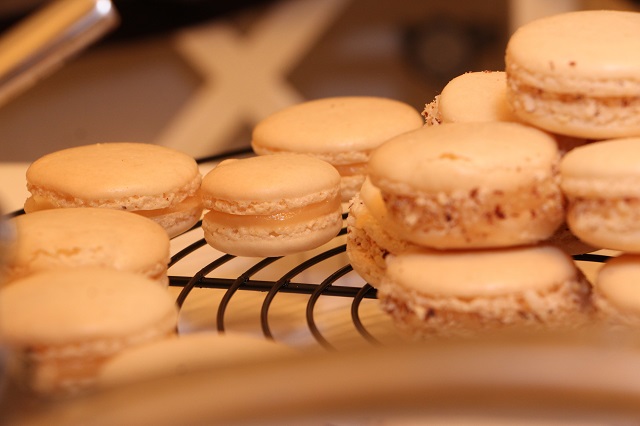
Sunday, 25th October – Until now, macarons are the ones which gave me the hardest time. The balance and quality of the ingredients are key. And one day, came the relief and satisfaction when the biscuits came out perfect. Here is the recipe and explanations to be succesful with your macarons. Never give up, there are days you will do great, and some others not. Keep trying. The article is pretty long but full of details and tips.
INGREDIENTS
Shells
- 100g egg white (3 eggs)
- 100g very fine caster sugar
- 120g icing sugar
- 80g almond powder
- 40g haselnut powder
Caramel salted butter ganache
- 250g caster sugar
- 75mL water
- 120mL cream
- 200g salted butter cut in little cubes
PREPARATION
Shells
- Stir together the almond powder, the haselnutt powder and the icing sugar. The powder should be very thin to obtain plain shells. Therefore, either sive the powders and the icing sugar (but this takes a lot of time) or use a mixer on first speed for some seconds until the powder is as thin as flour. Be careful not to mix too much otherwise the oil of the powders will come out and humidify the powder.
- Prepare the italian meringue. Put the egg whites in the mixer. Add a little bit of sugar at the beginning before starting the mixer. Start mixing then add the rest gradually. Mix until the meringue does the “bird’s beak”.
- Add half of the thin powder (almond, haselnutt, icing sugar) in the italian meringue. Incorporate carefully by putting the silicon spatula in the middle and turning the bowl, while reaching to the edges of the bowl. Once the first half well incorporated, add the second half using the same procedure.
- Once the thin powder is fully incorporated, start the “macaronnage”. The macaronnage is the process that will help the air of the preparation to come out. Place your spatula against the edge of the bowl and bring the upper part of the preparation to the center. You will see the air bubbles coming out. Follow this procedure until the preparation does “le ruban”, i.e. when you take a spatula of the preparation and hold it well above the bowl, it falls down continually just as a strip.
- Preheat the oven at 140°C / 285°F.
- Prepare a pastry bag with a round tip or make your own pastry bag! (video) Follow the instructions of the video to fill the pastry bag.
- Cut the baking paper at the size of your oven plate. Stick the corners of he baking paper with a little quantity of the preparation to avoid that the paper slides or rolls up.
- Spread the preparation in small disks of 3 cm on the baking paper. Follow the instructions on the video
- Let the shells dry 20 to 30 minutes at room temperature. This step is called the “croûtage”. This will help form a hard skin.
- After the croûtage, put the shells in the middle of the oven for 12 to 13 minutes. Watch them out and take them out when they are set (but not browned).
- Let them cool down completely before filling.
Salted butter caramel
- Put sugar and water in a saucepan and heat it over medium heat without stirring.
- Once the sugar melts into a thick brown, amber-coloured liquid, immediately drizzle in the cream while stirring.
- Using a thermometer, check the temperature of the caramel, and once it reaches 108°C / 227°F take it out of the heat.
- Stir in the salted butter cut in little cubes until you get a creamy salted butter caramel.
- Place the caramel in the fridge for 1 and half hour either in a separate bowl, or leave it in the saucepan.
Assembling
Fill in the shells with the caramel using a teaspoon. 1 1/2 teaspoon is usually enough. For the last touch, you can roll the formed macarons in haselnutt powder with help of your finger to make it stick to the caramel.
The Sweet Sunday Baker Tips & Tricks
- A normal +53g egg weights an average of 60g. Follow the 3, 2,1 rule to mesure your whites or yolks: 30g white, 20g yolks, 10g shell
- If your shell preparation is too liquid, the shells will spread while baking and be flat. Do the “ruban” check very often when you are doing the “macaronnage”. You better check often than not enough.
- Use a smooth oven plate to avoid that the shells become distorted while baking.
- Cut the baking paper at the size of the smooth part of your oven plate, again to avoid distortion of the shells.
- Do not put 2 plates in the oven at the same time. Do multiple batches.
- If the shells cracked this means that the almond, haselnutt, icing sugar powder was not fine enough.
- It can take a while until the sugar melts in caramel. Play a bit with the heat. Be patient too.
Comments